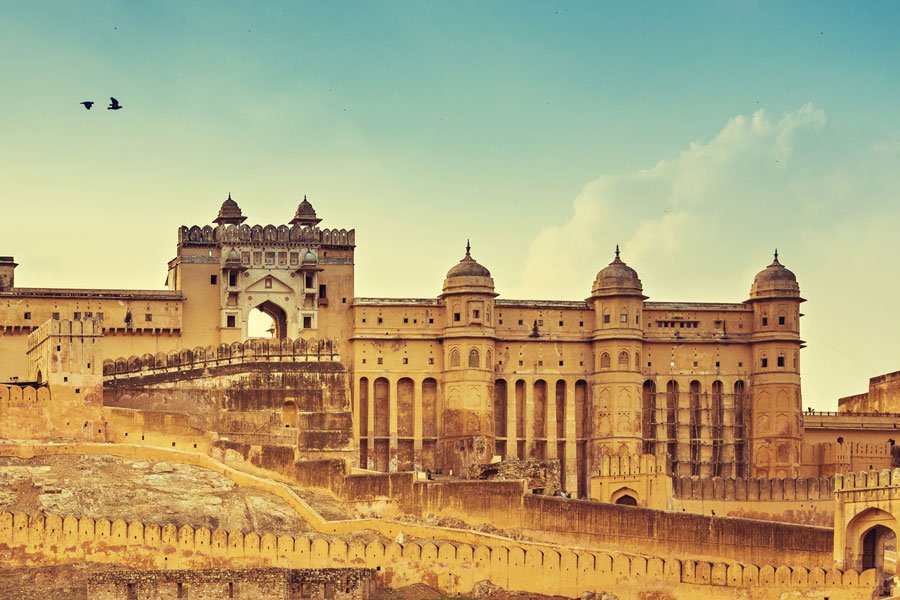The Golden Triangle in India—comprising Delhi, Agra, and Jaipur—is far more than just a tourist route; it is a cultural corridor where stories of empires, spirituality, artistry, and everyday life converge. This iconic trail is not merely about ticking monuments off a checklist; it’s about early morning fog over the Yamuna, marble reflecting the moonlight, chai shared with strangers at midnight, and colors that never fade with time. Through this narrative, we explore the Golden Triangle from a deeper, experiential lens—one that reflects both the lived reality and enduring legacies of North India.
Delhi: Where Empires Whisper Through Ruins
Delhi’s character is complex, shaped by centuries of political upheaval and cultural layering. In Old Delhi, the scent of cardamom mingles with the distant echo of a muezzin’s call. Narrow lanes lead to centuries-old spice markets and Mughal-era mansions that still bear the elegance of a bygone age. Chandni Chowk may overwhelm at first, but behind the chaos lies rhythm—life, trade, religion, and resilience functioning in harmony.
Contrast this with New Delhi’s geometry, a testament to colonial design and post-independence ambition. The wide boulevards, modern museums, and administrative buildings underscore the city’s duality: heritage and aspiration. Travelers often begin their journey here, grounding themselves in a city that has long been the seat of power.
Agra: Marble Dreams and Timeless Emotions
No matter how many times one sees the Taj Mahal in photographs, nothing prepares you for the real thing. At dawn, the monument appears to hover above the river like a spectral memory. It’s not just the architectural precision or the translucent white marble; it’s the emotional intensity behind it—the story of love and loss etched into stone.
But Agra is more than the Taj. The red sandstone of Agra Fort whispers of military strategy and royal family intrigues. Mehtab Bagh, across the Yamuna, offers a quieter, symmetrical perspective of the Taj—ideal for moments of reflection. Local crafts, particularly marble inlay and leatherwork, offer insights into the city’s artisanal heritage.
For travelers seeking a deeper engagement with India’s natural heritage, combining the Golden Triangle with a wildlife experience adds a fascinating dimension. A well-planned Golden Triangle Tour With Ranthambore brings together imperial grandeur and raw wilderness, where one can go from admiring marble facades to scanning forests for Bengal tigers, all in a matter of days.
Jaipur: Stories in Stone and Pigment
If Delhi is political and Agra emotional, Jaipur is artistic. Known as the Pink City, Jaipur is a masterpiece of Rajputana architecture, city planning, and symbolic color. Amber Fort, with its hilltop position and ornate courtyards, serves not just as a historic site but as a lens into feudal military lifestyles. Inside, frescoes and mirrored ceilings illustrate tales of devotion and valor.
Back in the city, the Hawa Mahal’s honeycomb façade is more than decorative—it was designed to let royal women observe street festivals in anonymity. The Jantar Mantar, a UNESCO World Heritage site, reflects the intellectual rigor of the Rajput kings who valued astronomy as much as warfare.
Markets in Jaipur—be it Johari Bazaar or Bapu Bazaar—overflow with block-printed fabrics, hand-cut gemstones, and blue pottery. Each piece tells a story of heritage sustained through generations. Exploring this city is best done slowly, taking time to listen to artisans, try a new spice, or sip chai on a rooftop while watching the city shift hues at sunset.
For those short on time yet eager to witness a slice of Rajasthan’s culture, a Mini Rajasthan Tour Package offers curated experiences across major cities like Jaipur, Jodhpur, and Udaipur. This compact journey captures the essence of the region—its palaces, markets, forts, and local flavors—without compromising on depth.
Midnight Conversations and Highway Teashops
No tale of the Golden Triangle is complete without mention of its highways. These roads, often long and winding, form the veins of the route, pumping life and stories between cities. Some of the most memorable moments occur not at landmarks, but at roadside tea stalls. It’s here, over a steaming glass of masala chai at midnight, that one chats with truck drivers, students, and fellow travelers. These transient conversations, though fleeting, often provide surprising insight into everyday Indian life.
The roadside dhabas (eateries) serve more than meals—they offer cultural immersion. Whether it’s a spicy paratha in the early morning mist or a sweet jalebi during an unplanned stop, every bite contributes to the overall narrative of the journey.
Extensions Beyond the Triangle: Spirituality and Stillness
For those wishing to go beyond the physical triangle and dive deeper into India’s spiritual side, destinations like Rishikesh offer a compelling addition. Known as the Yoga Capital of the World, Rishikesh balances the sensory intensity of the Golden Triangle with a calmer, more introspective experience.
The Golden Triangle Tour with Rishikesh blends architecture, history, and sacred tradition. Here, one can attend the Ganga Aarti at dusk, walk along suspension bridges that sway gently over the sacred river, or simply sit in silence by the ghats, listening to temple bells echo through the valley. The contrast of marble mausoleums and Himalayan stillness offers travelers a holistic view of India’s diversity.
Thematic Travel: Curating Meaningful Narratives
The Golden Triangle is not a rigid itinerary; it’s a thematic journey adaptable to one’s interests. Some travelers pursue culinary trails, exploring flavors from Mughlai kebabs in Delhi to Rajasthani thalis in Jaipur. Others trace architectural evolution, observing how styles shift from Sultanate to Mughal to Rajput influences.
The region also serves well for photography enthusiasts, history buffs, textile lovers, and those exploring India through the lens of sustainability or local traditions. What unites all these themes is the enduring human element: from artisans and priests to hoteliers and chai vendors, the people along this trail shape and reflect the region’s soul.




